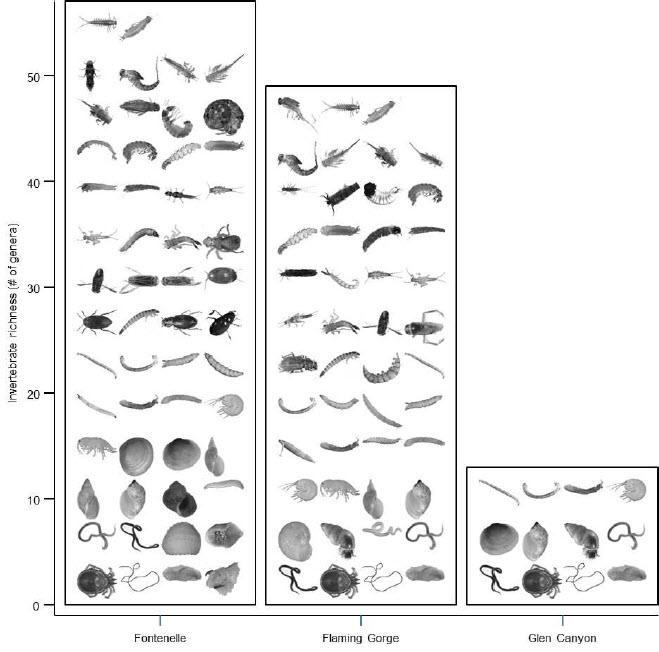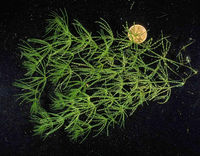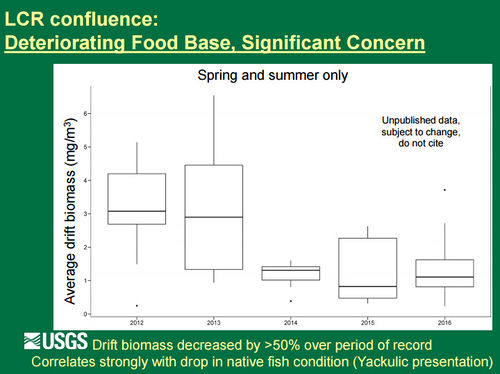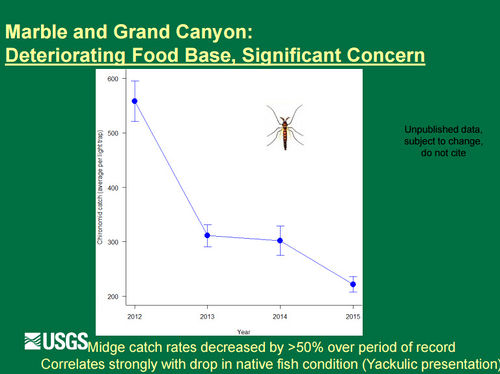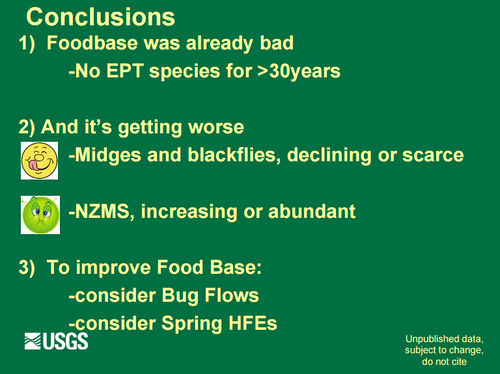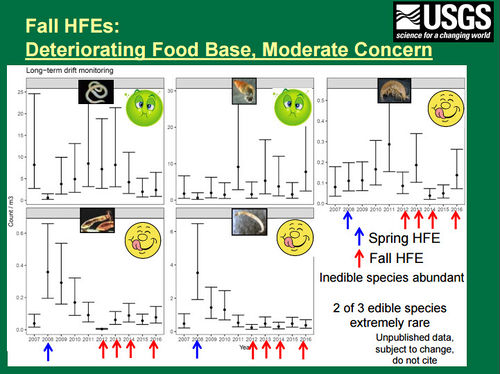Difference between revisions of "FOOD BASE"
Cellsworth (Talk | contribs) |
Cellsworth (Talk | contribs) |
||
| Line 129: | Line 129: | ||
'''2013''' | '''2013''' | ||
| + | *[http://www.gcmrc.gov/about/foodbase/Kennedy%20et%20al.%20FWB%20proofs.pdf Kennedy et al. 2013. The relation between invertebrate drift and two primary controls, discharge and benthic densities, in a large regulated river. Freshwater Biology.] | ||
| + | *[http://www.uwyo.edu/bhall/reprints/wellard_kelly2013.pdf Wellard-Kelly et al. 2013. Macroinvertebrate diets reflect tributary inputs and turbidity-driven changes in food availability in the Colorado River downstream of Glen Canyon Dam. Freshwater Science, 32(2):397-410. 2013.] | ||
*[[Media:Miller and Judson-2013-DriftAndHydropeaking.pdf| Miller and Judson. 2013. Responses of macroinvertebrate drift, benthic assemblages, and trout foraging to hydropeaking. Can. J. Fish. Aquat. Sci. 71: 675–687]] | *[[Media:Miller and Judson-2013-DriftAndHydropeaking.pdf| Miller and Judson. 2013. Responses of macroinvertebrate drift, benthic assemblages, and trout foraging to hydropeaking. Can. J. Fish. Aquat. Sci. 71: 675–687]] | ||
*[http://www.usbr.gov/uc/rm/amp/twg/mtgs/13nov06/Attach_02a.pdf GCMRC Update - Status of Resources and Sediment Conditions] | *[http://www.usbr.gov/uc/rm/amp/twg/mtgs/13nov06/Attach_02a.pdf GCMRC Update - Status of Resources and Sediment Conditions] | ||
| − | |||
*[http://www.gcmrc.gov/about/annaul_reporting/Tuesday%201_22_13/6.%20Kennedy_2013Annual%20Report.pdf Annual Reporting Meeting: Foodbase Update] | *[http://www.gcmrc.gov/about/annaul_reporting/Tuesday%201_22_13/6.%20Kennedy_2013Annual%20Report.pdf Annual Reporting Meeting: Foodbase Update] | ||
*[https://www.usbr.gov/uc/rm/amp/twg/mtgs/13jan24/7_Kennedy.pdf Foodbase Update] | *[https://www.usbr.gov/uc/rm/amp/twg/mtgs/13jan24/7_Kennedy.pdf Foodbase Update] | ||
| Line 142: | Line 143: | ||
'''2010''' | '''2010''' | ||
| + | *[http://www.montana.edu/wcross/Cross_website/Publications_files/Cross%20et%20al.%202010.pdf Cross et al. 2010. Invasion and production of New Zealand mud snails in the Colorado River, Glen Canyon. Biol Invasions] | ||
*[http://pubs.usgs.gov/of/2010/1031/of2010-1031.pdf Short-Term Effects of the 2008 High-Flow Experiment on Macroinvertebrates in Colorado River Below Glen Canyon Dam, Arizona] | *[http://pubs.usgs.gov/of/2010/1031/of2010-1031.pdf Short-Term Effects of the 2008 High-Flow Experiment on Macroinvertebrates in Colorado River Below Glen Canyon Dam, Arizona] | ||
*[http://pubs.usgs.gov/of/2010/1075/of2010-1075.pdf Basal Resources in Backwaters of the Colorado River Below Glen Canyon Dam—Effects of Discharge Regimes and Comparison with Mainstem Depositional Environments] | *[http://pubs.usgs.gov/of/2010/1075/of2010-1075.pdf Basal Resources in Backwaters of the Colorado River Below Glen Canyon Dam—Effects of Discharge Regimes and Comparison with Mainstem Depositional Environments] | ||
| + | |||
| + | '''2002''' | ||
| + | *[http://www.bioone.org/doi/abs/10.1894/0038-4909(2003)048%3C0023:BCSOTG%3E2.0.CO%3B2 Bentic community structure of the Green and Colorado Rivers through Canyonlands National Park, Utah, USA. The Southwestern Naturalist] | ||
'''2001''' | '''2001''' | ||
*[http://www.riversimulator.org/Resources/GCMRC/FoodBase/Shannon2001b.pdf Shannon et al. 2001. Aquatic food base response to the 1996 test flood below Glen Canyon Dam, Colorado River, Arizona. Ecological Applications, 11(3), 2001, pp. 672–685.] | *[http://www.riversimulator.org/Resources/GCMRC/FoodBase/Shannon2001b.pdf Shannon et al. 2001. Aquatic food base response to the 1996 test flood below Glen Canyon Dam, Colorado River, Arizona. Ecological Applications, 11(3), 2001, pp. 672–685.] | ||
| + | |||
| + | '''2000''' | ||
| + | *[https://www.gcmrc.gov/library/reports/biological/Foodbase/Blinn2000.pdf Blinn et al. 2000. Environmental Conditions Associated with Cladophora glomerata, Oscillatoria spp and Miscellaneous Algae, Macrophytes, and Bryophytes (MAMB). Report to GCMRC. ] | ||
'''1999''' | '''1999''' | ||
| − | *[http://www.gcmrc.gov/library/reports/biological/Foodbase/Oberlin1999.pdf | + | *[http://www.gcmrc.gov/library/reports/biological/Foodbase/Oberlin1999.pdf Oberlin et al. Watershed influence on the macroinvertebrate fauna of ten major tributaries of the Colorado River through Grand Canyon, Arizona. The Southwestern Naturalist 44(1):17-30. ] |
| + | |||
| + | '''1998''' | ||
| + | *[https://www.gcmrc.gov/library/reports/biological/Foodbase/Blinn1998b.pdf Blinn et al. 1998. Algal ecology in the tailwater stream communities: The Colorado River below Glen Canyon Dam, Arizona. J, Phycol. M, 734-740 (1998)] | ||
| + | *[http://scholarsarchive.byu.edu/cgi/viewcontent.cgi?article=3242&context=gbn Stevens et al. 1998. Chironomidae (Diptera) of the Colorado River, Grand Canyon, Arizona, USA, II: factors influencing distribution. Great Basin Naturalist: Vol. 58: No. 2, Article 2] | ||
'''1997''' | '''1997''' | ||
*[http://www.riversimulator.org/Resources/GCMRC/PhysicalResources2/Shaver1997.pdf Shaver et al. Effects of suspended sediment and desiccation on the benthic tailwater community in the Colorado River, USA. Hydrobiologia 357: 63–72, 1997. ] | *[http://www.riversimulator.org/Resources/GCMRC/PhysicalResources2/Shaver1997.pdf Shaver et al. Effects of suspended sediment and desiccation on the benthic tailwater community in the Colorado River, USA. Hydrobiologia 357: 63–72, 1997. ] | ||
| + | *[http://www.academia.edu/29251275/Colorado_River_benthic_ecology_in_Grand_Canyon Stevens et al. 1997. Colorado River benthic ecology in Grand Canyon, Arizona, USA: Dam, tributary, and gomorphological influences. | ||
| + | Regulated Rivers: Research and Management, Vol. 13, 129–149 (1997)] | ||
| + | |||
| + | '''1994''' | ||
| + | *[https://www.researchgate.net/publication/227682979_Trophic_interactions_and_benthic_animal_community_structure_in_the_Colorado_River_Arizona_USA Shannon et al. 1994. Trophic interactions and benthic animal community structure in the Colorado River, Arizona, U.S.A. Freshwater Biology 31(2):213 - 220.] | ||
'''1991''' | '''1991''' | ||
| − | *[http://www.riversimulator.org/Resources/GCMRC/FoodBase/Haury1991.pdf Zooplankton of the Colorado River: Glen Canyon Dam to Diamond Creek] | + | *[http://www.riversimulator.org/Resources/GCMRC/FoodBase/Haury1991.pdf Haury 1991. Zooplankton of the Colorado River: Glen Canyon Dam to Diamond Creek] |
| − | *[https://www.gcmrc.gov/library/reports/gces/Blinn1991.pdf Algal and Invertebrate Biota in the Colorado River: Comparison of Pre- and Post-Dam Conditions] | + | *[https://www.gcmrc.gov/library/reports/gces/Blinn1991.pdf Blinn and Cole. 1991. Algal and Invertebrate Biota in the Colorado River: Comparison of Pre- and Post-Dam Conditions. In Colorado River Ecology and Dam Management.] |
'''1981''' | '''1981''' | ||
| − | *[http://www.gcmrc.gov/library/reports/GrandCanyon/Carothers1981.pdf A survey of the aquatic flora and fauna of the Grand Canyon] | + | *[http://www.gcmrc.gov/library/reports/GrandCanyon/Carothers1981.pdf Carothers and Minckley. 1981. A survey of the aquatic flora and fauna of the Grand Canyon: A Survey of the Fishes, Aquatic Invertebrates and Aquatic Plants of the Colorado River and Selected Tributaries form Lee Ferry to Separation Rapids. Final Report to DOI] |
'''1959''' | '''1959''' | ||
| − | *[http://core.tdar.org/document/92630/ecological-studies-of-the-flora-and-fauna-in-glen-canyon Ecological Studies of the Flora and Fauna in Glen Canyon ( | + | *[http://core.tdar.org/document/92630/ecological-studies-of-the-flora-and-fauna-in-glen-canyon Woodbury et al. 1959. Ecological Studies of the Flora and Fauna in Glen Canyon. Anthropological Papers (Glen Canyon Series Number 7) ,40. Salt Lake City, Ut: University of Utah Press. ] |
|- | |- | ||
Revision as of 09:29, 11 May 2017
|
|
The Aquatic Food Base below Glen Canyon DamThe Colorado River below Glen Canyon Dam has been altered by dam-induced modifications to the river’s flow, temperature, and sediment supply. Nonnative species have also changed the natural system. Nonnative fish are thought to prey on and compete with native fish, including the endangered humpback chub (Gila cypha). These impacts have likely changed both the amount and sources of energy that fuel the aquatic food web and the flows of energy within the food web. Installation of the dam created a relatively clear, cool aquatic environment below the dam that now allows aquatic plants to capture the sun’s energy, and they in turn are now consumed by a few species, including scuds (Gammarus lacustris), midges (Family: Chironomidae), blackflies (Simulium arcticum), and New Zealand mudsnails (Potamopyrgus antipodarum). The first three species can provide food for both native and nonnative fishes, but fish cannot digest the New Zealand mudsnail. Desired Future Condition for the Aquatic Food BaseThe aquatic food base will sustainably support viable populations of desired species at all trophic levels. Assure that an adequate, diverse, productive aquatic foodbase exists for fish and other aquatic and terrestrial species that depend on those food resources. |
| EPT as Biologic Indicators of Stream Condition |
Algae and Aquatic Macrophytes |
Aquatic Macroinvertebrates |
|---|
